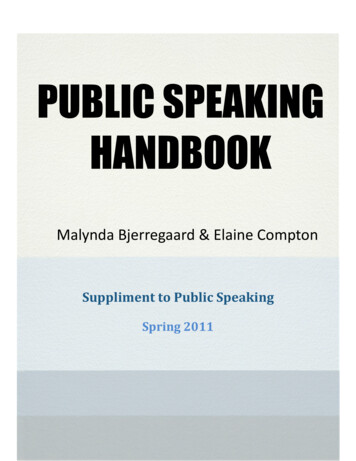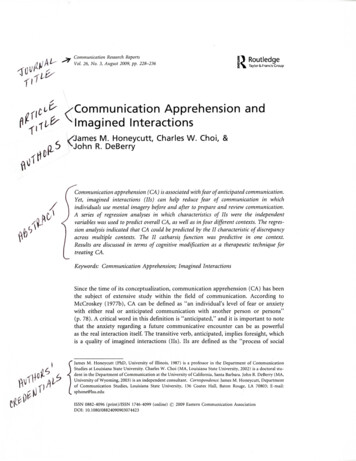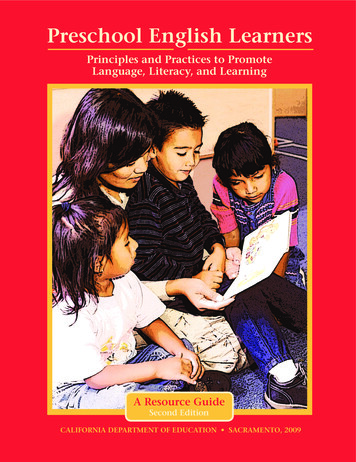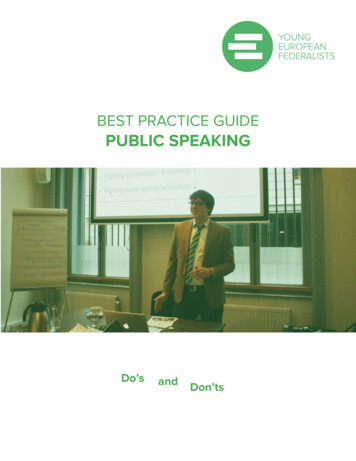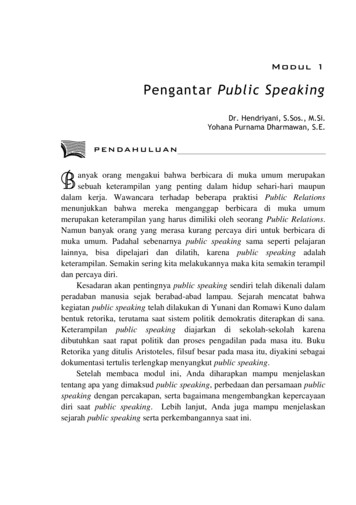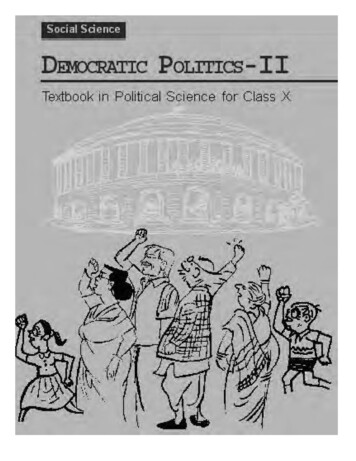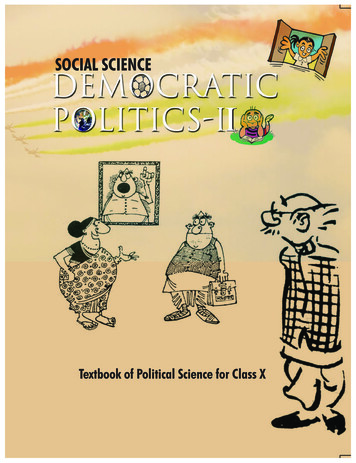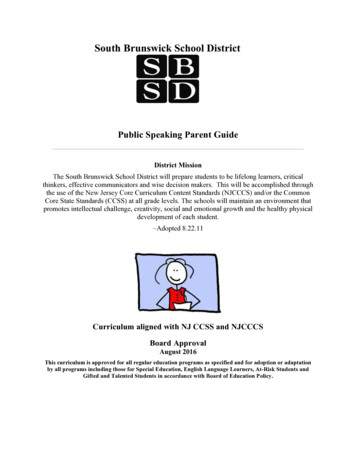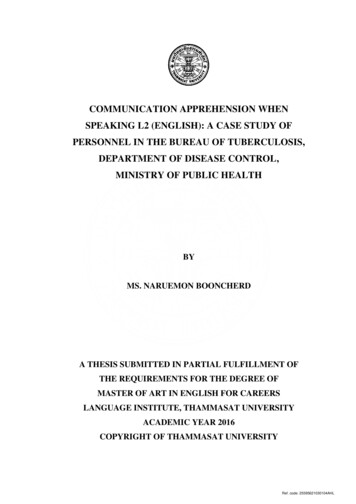
Transcription
COMMUNICATION APPREHENSION WHENSPEAKING L2 (ENGLISH): A CASE STUDY OFPERSONNEL IN THE BUREAU OF TUBERCULOSIS,DEPARTMENT OF DISEASE CONTROL,MINISTRY OF PUBLIC HEALTHBYMS. NARUEMON BOONCHERDA THESIS SUBMITTED IN PARTIAL FULFILLMENT OFTHE REQUIREMENTS FOR THE DEGREE OFMASTER OF ART IN ENGLISH FOR CAREERSLANGUAGE INSTITUTE, THAMMASAT UNIVERSITYACADEMIC YEAR 2016COPYRIGHT OF THAMMASAT UNIVERSITYRef. code: 25595621030104AHL
COMMUNICATION APPREHENSION WHENSPEAKING L2 (ENGLISH): A CASE STUDY OFPERSONNEL IN THE BUREAU OF TUBERCULOSIS,DEPARTMENT OF DISEASE CONTROL,MINISTRY OF PUBLIC HEALTHBYMS. NARUEMON BOONCHERDA THESIS SUBMITTED IN PARTIAL FULFILLMENT OFTHE REQUIREMENTS FOR THE DEGREE OFMASTER OF ART IN ENGLISH FOR CAREERSLANGUAGE INSTITUTE, THAMMASAT UNIVERSITYACADEMIC YEAR 2016COPYRIGHT OF THAMMASAT UNIVERSITYRef. code: 25595621030104AHL
(1)Thesis TitleCOMMUNICATION APPREHENSION WHENSPEAKING L2 (ENGLISH): A CASE STUDYOF PERSONNEL IN THE BUREAU OFTUBERCULOSIS, DEPARTMENT OF DISEASECONTROL, MINISTRY OF PUBLIC HEALTHAuthorMiss Naruemon BooncherdDegreeMaster’s DegreeMajor Field/Faculty/UniversityEnglish for CareerLanguage InstituteThammasat UniversityThesis AdvisorAssociate Professor Sucharat Rimkeeratikul, Ph.D.Academic Years2016ABSTRACTEnglish communication apprehension in a second language has been a focus in manyprofessional fields. Although English is the primary second language used in Thailandincluding in the public health area, there has been less emphasis on researching in thepublic health profession in Thailand. This study aimed to investigate the level ofparticipants’ communication apprehension in L1 (Thai) and L2 (English), howdemographic information affected CA in L2 and the techniques they used when facingCA in L2. This study was a mixed method utilizing quantitative and qualitative data of92 personnel of the Bureau of Tuberculosis, Department of Disease Control, Ministryof Public Health. The quantitative data were collected through a questionnaire. ThePersonal Report of Communication Apprehension-24 (PRCA-24) was employed tomeasure the level of CA in L1 and L2. The qualitative data were obtained from sixinterviewees who were found to have high and low levels of CA in L1 and L2. Theywere asked how they coped with an oral communication apprehension. The interviewdata were transcribed into verbatim transcriptions and reduced to the main themes. Inaddition, the NVivo 10 software program was used for to check the data’s accuracy.ANOVA analysis revealed that years of working and different positions affected CA inL2. Although the quantitative results indicated that the levels of CA both in L1 and L2of BTB staff members were categorized as moderate, the qualitative data revealed thatRef. code: 25595621030104AHL
(2)they still hesitated to perform in English communication circumstances. They alsostruggled to implement solutions to overcome their CA in L2.Keywords: Communication Apprehension (CA), L1, L2, public health, demographiccharacteristics, techniques dealt with CARef. code: 25595621030104AHL
(3)ACKNOWLEDGEMENTSFirst of all, I would like to thank my thesis advisor, Associate Professor SucharatRimkeeratikul, Ph.D., of the Language Institute at Thammasat University. Without herencouragement, this study would not have been completed. She consistently allowedthis paper to be my own work, but also steered me in the right direction whenever shethought I needed it.I would also like to acknowledge my ex-colleagues at Thailand MOPH U.S.-CDCCollaboration and Bureau of Tuberculosis, Department of Disease Control, Ministry ofPublic Health, Thailand who were involved in the validation survey for this researchproject. Without their participation and input, the validation survey could not have beensuccessfully conducted.Also, I would like to thank my thesis committee and lecturers, as well as my classmatesand staff members of the Language Institute at Thammasat University for their support,both academic and emotional.Finally, I must express my very profound gratitude to my parents and my family forproviding me with unfailing support and continuous encouragement throughout myyears of study and during the process of researching and writing this thesis. Thisaccomplishment would not have been possible without them. Thank you.Miss Naruemon BooncherdRef. code: 25595621030104AHL
(4)TABLE OF CONTENTSPageABSTRACT(1)ACKNOWLEDGEMENTS(3)LIST OF TABLES(7)LIST OF FIGURES(8)CHAPTER 1 INTRODUCTION11.1Background11.2Research Questions21.3Hypothesis31.4Objectives of the study31.5Scope of the Study31.6Significance of the Study41.7Definition of Terms41.8Limitations of the Study51.9Summary of the Introduction5CHAPTER 2 REVIEW OF LITERATURE72.1Conceptualization of Communication Apprehension2.1.1Communication Apprehension as a trait (Trait-like CA)2.1.2Communication apprehension in a generalized context77(Context-based CA-dyadic, groups, meetings, public speakingand interviews)2.1.32.1.48Communication apprehension with a given audience acrosssituations (Audience-based CA)8Situational Anxiety or State Anxiety9Ref. code: 25595621030104AHL
(5)2.2Causes and Effects of Communication Apprehension92.2.1Causes of Communication Apprehension92.2.2Effects of Communication Apprehension112.2.3Cultural differences122.2.4Relevant studies on causes and effects of communicationapprehension132.3Communication Apprehension Measurement172.4Communication Apprehension in Second Language (CA in L2)192.5How to Cope with CA212.6Background on Bureau of Tuberculosis232.7Summary of Review of Literature24CHAPTER 3 RESEARCH METHODOLOGY253.1Participants253.2Research Instruments253.3Procedures263.43.3.1Research Design263.3.2Data Collection27Data Analysis283.4.1Quantitative Analysis283.4.2Qualitative Analysis283.5Pilot Study303.6Summary of the Researh Methodoloty30CHAPTER 4 RESULTS32Part I Demographic Data32Part II CA in L1 and CA in L2 of Participants35Part III The Comparison of Demographic Data to CA in L1 and L235Part IV The Results of the Interview Session44Summary of the Results68Ref. code: 25595621030104AHL
(6)CHAPTER 5 Discussion, Conclusion, and Recommendations5.169Summary of the Finding695.1.1Research Question 1695.1.2Research Question 2705.1.3Research Question 3705.1.4Results of the interview session715.2Discussion5.2.1What is the average level of communication apprehensionin L1 and L2 of BTB personnel?5.2.272Are personnel in BTB impeded with L2 communicationapprehension when communicating with foreigners?5.2.471What demographic information is associated with BTBpersonnel’s communication apprehension in L1 and L2?5.2.37175Discussion of hypothesis: The personnel of Bureau ofTuberculosis have lower communication apprehension5.2.5in their native language than in the English language.76Answers from the interview sessions775.3Conclusion795.4Recommendations for further research815.5Implications of the Study82REFERENCES83APPENDICES91BIOGRAPHYAPPENDIX A92APPENDIX B95APPENDIX C108APPENDIX D109137Ref. code: 25595621030104AHL
(7)LIST OF TABLESTablesTable 2.1Major Characteristics of Individualistic and Collectivistic Cultures(Tubbs & Moss, 2008, p.319)13Table 4.1Gender of Participants33Table 4.2Frequency Statistics for Age33Table 4.3Frequency Statistics for Education33Table 4.4Frequency Statistics of Positions34Table 4.5Frequency Statistics of Years of Working34Table 4.6Frequency Statistics of Overseas Experience34Table 4.7CA Level in L1 and L235Table 4.8Total CA in L1 Score with Different Genders36Table 4.9Total CA in L2 Score with Different Genders36Table 4.10 Total CA in L1 Score with Different Ages36Table 4.11 Total CA in L2 Score with Different Ages37Table 4.12 Total CA in L1 Score with Different Education37Table 4.13 Total CA in L2 Score with Different Education38Table 4.14 Total CA in L1 Score with Different Positions38Table 4.15 Total CA in L2 Score with Different Positions39Table 4.16 Post-hoc Analysis of Total CA in L2 Score with the Positions39Table 4.17 Total CA in L1 Score with Different Years of Working40Table 4.18 Total CA in L2 Score with Different Years of Working40Table 4.19 Post-hoc Analysis of Total CA in L2 Score with Years of Working41Table 4.20 Total CA in L1 Score with Overseas Experience41Table 4.21 Total CA in L2 Score with Overseas Experience42Table 4.22 Total CA in L2 Score with Period of Overseas Experience42Table 4.23 Total CA in L2 Score with the Purpose of Travelling Abroad42Table 4.24 Comparison of CA Scores in L1 and L243Table 4.25 Theme of the interviewees52Table 4.26 Summary of Techniques used65Ref. code: 25595621030104AHL
(8)LIST OF FIGURESFiguresFigure 1Analytical FrameworkFigure 2Continuum from High-Context to Low-Context Cultures4(Williams et al. 2008, p.39)13Figure 3Data Analysis in Qualitative Research (Creswell, 2014)29Figure 4Mind Map of the Frequency of “English”55Figure 53D Word Cloud of Word Frequency56Figure 6Word Tree of Frequent Words57Figure 7Mind Map of the Frequency of “Information”58Figure 8Mind Map of the Frequency of “Prepare”59Figure 9.1 Word Cluster of Frequent Words60Figure 9.2 Word Cluster of Frequent Words61Ref. code: 25595621030104AHL
1CHAPTER 1INTRODUCTION1.1BackgroundThe collaboration between countries in the same region is significant insupporting the security and economic growth of each region such as the EuropeanUnion (EU), Asia-Pacific Economic Cooperation (APEC) and Group of Seven or G7(consist of seven countries - the United States of America, United Kingdom, France,Germany, Italy, Japan and Canada). Ten countries in South East Asia formed theASEAN Economic Community (AEC), which launched at the end of 2015. Itestablished a common market between ten ASEAN countries: Thailand, Myanmar,Laos, Vietnam, Malaysia, Singapore, Indonesia, Philippines, Cambodia, and Brunei.All members agree to use English as the working language of AEC1. According toSeidlhofer (2011), English has become a global language that has spread all over theworld. Moreover, English is a primary foreign language in school syllabuses around theworld. Many countries that conduct various activities across the world use English asan international language.The Thai government has set a policy to turn Thailand into a medical hub forthe region to support the arrival of AEC (Yongwikai, 2013), as medical treatment inThailand has a good reputation in terms of technology and services such as cardiologyand cancer treatment. Therefore, an increasing number of patients and foreigners fromneighboring countries will come to Thailand for medical services. Moreover, thevarieties of collaboration in medical technology between Thailand and many countriesare increasing. Those facilitators who come from USA, UK, Australia, Japan, India,China and South Africa will use English as an international language forcommunication in conferences, workshops or site visits.Taylor, Nicolle and Maguire (2013) conducted a study, which showed thesignificance of communication in healthcare. Their study recognized the essence ofeffective communication to ensure patients safety, correction of rules and regulations,accurate diagnosis and health promotion.Since Thai medical technicians willcommunicate in English with a growing number of service receivers, they will alsohave to communicate in English properly with confidence to their patients and visitors.1(ASEAN Charter)Ref. code: 25595621030104AHL
2Moreover, the medical technicians have to be concerned about differences in culture,context, race, ethnicity and religion, as these significant factors may lead to attainingthe standard of effective communication. Language barriers and cross-culture are alsoproblems of communication in healthcare (Taylor et al. 2013).However, some people may have problems communicating in English and facefactors that obstruct their effective communication in English. It is not simple toconfidently communicate in English properly with foreigners in a medical context.One of the reasons this may occur is from anxiety, which may lead to a problem whencommunicating in English for medical technicians. Booth-Butterfiled, Chory andBeynon (1997) state that communication apprehension has not received much interestin relation to healthcare. This issue has to be resolved urgently; if not, it may lead tonegative performances from technicians as they may avoid communicating or engagingwith foreigners. The Bureau of Tuberculosis (BTB) is one of the bureaus of theDepartment of Disease Control, Ministry of Public Health that has to deal with manyexperts and specialists from around the world. These people from the World HealthOrganization (WHO) and other international health organizations will provide theknow-how of new technology to BTB and exchange experience in terms of diagnosisand treatment methods to BTB. Certainly, English is needed in order to communicatewith these people in all areas.Richmond and McCroskey (1998, p.37) estimated that 20 percent of people areafflicted with communication apprehension and these people tend to withdraw fromcommunication situations. This study will examine whether personnel in the medicalfield are apprehensive when speaking English to foreigners.It is an essential to findout the main factors of oral English communication problems. In addition, the studywill offer some suggestions to improve English speaking skills for personnel at both theBureau of Tuberculosis and other public health organizations in Thailand.1.2Research QuestionsThis study aimed to answer the following questions:1.2.1What are the average scores and levels of communication apprehensionin L1 and L2 of BTB personnel?1.2.2What demographic information is associated with CA in L1 and CA inL2 of BTB personnel?Ref. code: 25595621030104AHL
31.2.3Are personnel in the Bureau of Tuberculosis affected by L2communication apprehension when communicating with foreigners?1.3HypothesisThis study was designed and conducted in order to test the hypothesis asfollows:H1.The personnel of the Bureau of Tuberculosis have lower communicationapprehension in their native language (L1) than in English language (L2).1.4Objectives of the studyThe study has the objectives as follows:1.4.1To investigate the scores and compare CA in L1 and L2 of BTBpersonnel.1.4.2To explore the characteristics that affect communication apprehension inthe personnel of BTB.1.4.3To explore the level of communication apprehension in BTB personnelwhen performing L2 oral communication.1.5Scope of the StudyThis study was conducted with personnel of the Bureau of Tuberculosis,Department of Disease Control, Ministry of Public Health, Thailand. The study focuseson 129 personnel consisting of medical officers, registered nurses, medicaltechnologists, medical scientists, medical lab technicians, pharmacists, pharmacytechnicians, radiological technologists, radiographer technicians, public health officers,social workers and administrative officers. The participants had to deal with foreignexperts and/or public health specialists. This study examined the correlation betweenL1 and L2 of CA levels in medical professional personnel including administrativepersonnel.In addition, the demographic data was compared with CA levels todetermine whether this affected L2 communication apprehension.Ref. code: 25595621030104AHL
4Figure 1 illustrates the introduction of the analytical framework. As can be seen, theindependent variables are demographic data including gender, age, position,educational background, year(s) of working and overseas experience. The dependentvariable is levels of CA in L1 and CA in L2.Independent VariableDependent Variable Demographic Data Educational Background Working Experience Overseas ExperienceLevels of CommunicationApprehension in L1 and L2Figure 1: Analytical Framework1.6Significance of the StudyThe study of communication anxiety of the personnel in BTB is significant inmany aspects as follows:1.6.1The outcome of this study will help BTB staff to recognize the causes ofproblems in oral English communication that may affect their working performance.Furthermore, the results will assist them to reduce their problem of L2 communication.1.6.2The Personnel Division, Department of Disease Control, Ministry ofPublic Health will be able to use the data and results from this study to develop andimplement appropriate English courses for the personnel in the BTB and Ministry ofPublic Health to improve their oral English skills.1.7Definition of TermsThe definition of the terms of this study are as follows:“BTB” refers to the Bureau of Tuberculosis, Department of Disease Control,Ministry of Public Health, Thailand.“CA in L2” refers to a worried feeling when speaking in English. This feelingwill be reflected in the performance in English communication with foreigninterlocutors.“Communication Apprehension (CA)” is defined as an individual’s level offear or anxiety associated with either real on anticipated communication with anotherperson or persons (McCroskey & Beatty, 1984).Ref. code: 25595621030104AHL
5“Foreigners” refers to foreign visitors, public health specialists and/or expertswho provide and/or receive public health knowledge to/from the medical technicians ofBTB in job training, conferences, meetings or workshops.“L1” means native language. In this study L1 means Thai language.“L2” refers to English as an international language, which is used tocommunicate among personnel of the BTB and with foreign visitors.“Personnel” refers to medical officers, registered nurses, medical technologists,medical scientists, medical lab technicians, pharmacists, pharmacy technicians,radiological technologists, radiographer technicians, public health officers, socialworkers, public relations officers, administrative officers, i.e., personnel officers,finance/accounting officers, computer technical officers, statisticians, policy andplanninganalyst officers and general administrative officers of the Bureau ofTuberculosis, Department of Disease Control, Ministry of Public Health, Thailand.“PRCA-24” refers to the Personal Report of Communication Apprehension. Itis a measurement of communication apprehension used to determine the level of CA ina person that was developed by McCroskey (1978).1.8Limitations of the StudyThere are two limitations of this study:1.8.1This study highlighted only Thai and English oral communicationapprehension in personnel of the BTB.Examinations in writing and listeningcommunication have not been included; otherwise, the generalization in those skillsmay reveal different outcomes.1.8.2The researcher focused on the personnel who were working in the publichealth area in Bangkok.These people have more chances to communicate withforeigners than public health personnel working in rural areas. Thus, the results mayshow only the problems of the people in urban areas.1.9Summary of the IntroductionThis chapter has presented the background and the significance of Englishcommunication in the public health area. The researcher sought to investigate thereadiness of personnel in this area when entering the AEC community.Communication apprehension might limit the proficiency of working performance interms of obtaining new methods of diagnosis, treatment, and learning new technologiesRef. code: 25595621030104AHL
6in the public health area, which may in turn act as an impediment to public healthdevelopment in Thailand.This chapter has highlighted the purposes, analyticalframework, key terms as well as the limitations of the study.Ref. code: 25595621030104AHL
7CHAPTER 2REVIEW OF LITERATUREThe key concepts reviewed in this chapter concern the following: (1)Conceptualization of communication apprehension, (2) Causes and effects ofcommunication anxiety, (3) Communication apprehension measurement, (4) CA in L2,(5) How to cope with CA, and (6) Background of the Bureau of Tuberculosis.2.1Conceptualization of Communication ApprehensionCommunication Apprehension (CA) or Communication Anxiety is defined asan individual’s level of fear or anxiety associated with either real on anticipatedcommunication with another person or persons (Beatty, McCroskey & Heisel 1998).McCroskey (1970) considers that CA is “broadly based anxiety related to oralcommunication.” Communication anxiety is clearly an obstacle to communication.Moreover, people who encounter CA tend to decrease or avoid communication. Fear ofcommunication is an internal feeling that makes people withdraw from communicationwith others (Richmond & McCroskey, 1998). It is important to understand the types ofcommunication anxiety as defined by Richmond and McCroskey (1998), who dividedcommunication apprehension into four categories as detailed below:2.1.1Communication Apprehension as a trait (Trait-like CA)Trait-like CA is related to the personality of the speaker. It is the internalanxiety that an individual brings to a speaking situation. Richmond and McCroskey(1998, p.43) define this kind of CA as an actual trait, e.g., eye color, height and weight,which are not able to change. Although we can change our eye colors by using contactlenses, the real eye color cannot be changed. According to Pongpun (2012, p.9), “Traitanxiety is explained as a fixed stage of anxiety or a part of a person’s personality”.Someone with high trait anxiety is presumed to be frightened in communicationsituations, while a person with state anxiety is likely to be frightened only in specificcontexts, such as speaking or interpersonal settings.Booth-Butterfield, Chory and Beynon (1997) state that “people who experienceeither higher trait CA or specific health state CA will probably communicate lesseffectively with their health care providers about their health problems.” If a medicaltechnician or patient is uncomfortable to communicate with each other directly, thepatient will receive less effective healthcare service.Ref. code: 25595621030104AHL
82.1.2Communication apprehension in a generalized context (Context-based CA-dyadic, groups, meetings, public speaking and interviews)This kind of CA is considered as “a relatively enduring, personality-typeorientation toward communication in a given type of context” (Daly & McCroskey1984, p.16). This type of CA is associated with people who are frightened ofcommunicating in one type of situation while they are not afraid in other situations. Forexample, people may be anxious when speaking in front of a large number of people ordoing public speaking. On the other hand, they feel comfortable to talk with closefriends.Type of context-based CA consists tionbetween two persons via channels of communication such as a telephone, e-mail, textmessage or social website (Adler, Rodman, & du Pré, 2014, p.11).(2)Small Group Communication: this refers to a group of more thanthree people associating in face-to-face communication and working together towardthe same goal. The effective size of small groups for sufficient communication isbetween five to eight persons (Hamilton, 2014, p. 262).(3)Meeting Group Communication: this refers to a group of peoplein a profit or non-profit organization engaging in formal communication (Adler et al,2014, p. 12). Meeting group communication refers to groups of more than seven(Degner, 2010).(4)Public Speaking: this means one or more people communicatingto a large number of people who participate as an audience (Adler et al., 2014, p. 13).2.1.3Communication apprehension with a given audience acrosssituations (Audience-based CA)This type of CA is focused on people’s feedback when communicatingwith a given individual or group of individuals across time (Richmond and McCroskey,1998, p.46). This kind of CA is viewed as “a relatively enduring orientation towardcommunication with a given person or group of people” (McCroskey, 1984, p.17).These particular individuals or groups of individuals may cause communicationanxiety, such as students talking with their teacher or going on a job interview.Ref. code: 25595621030104AHL
92.1.4Situational Anxiety or State AnxietySituational Anxiety is a temporary emotion arising from specificsituational factors. Some people may become anxious prior to a new communicationsituation. For example, a doctor may feel uncomfortable discussing with foreignpatients in English, but with Thai patients they may feel comfortable. They becomenervous, afraid, or excited, and their body’s nervous system prepares them for actionwith a big shot of adrenaline, which accelerates the heart rate; sends extra oxygen to thecentral nervous system, heart, and muscles; dilates the eyes; raises the blood sugarlevel; and causes perspiration (Hamilton, 2014, p.177). High or low levels of stateanxiety may occur depending on the specific situation (Pongpun, 2012, p.9). This kindof CA can be alleviated by practicing before the occurrence of situation such as Englishpractice in classroom or daily life. Richmond, Smith, Heisel, and McCroskey (1998)found that patients’ state CA or fear of physicians (FOP) was higher than trait CA. Inaddition, high FOP leads to decreased satisfaction with healthcare.2.2Causes and Effects of Communication ApprehensionAs English is not the mother tongue or native language of Thai people, it maynot be easy for people who do not use English regularly in daily life. Many Thai peoplemight feel anxious and uncomfortable to communicate with a foreigner in anotherlanguage. Some people may speak another language when they are forced to, whichwill increase their anxiety to speak the other language. Therefore, the causes and effectsof communication anxiety is the one of the important issues that needs to be discussedin this study.2.2.1Causes of Communication ApprehensionThere are two categories of causes of communication apprehension –Trait-like Communication Apprehension and Situation Communication. In this study,the focus is on Trait-like CA.2.2.1.1 Causes of Trait-like Communication ApprehensionTrait-like communication apprehensionistheresultofpersonality. Trait-like CA stems from family background and environment, which maypredispose people to having high or low CA (Richmond & McCroskey, 1998, p.49).Apprehensive people may avoid communicating with almost anyone in anycircumstance (DeFleur, Kearney, Plax & DeFleur, 2014, p.269). DeFleur et al. (2014,Ref. code: 25595621030104AHL
10p.270) also mention that trait-like CA is grounded in past experience. Social scientistsdo not contend that trait-like CA is based on genetics.However, in the past twenty years, psychobiologists andcommunication apprehension researchers have claimed that trait-like communicationapprehension results from biological functioning and social learning processes (Beatty,McCroskey, & Heisel, 1998; McCroskey & Beatty, 2000). They argue that it isgenetically linked to personality traits, which they refer to as “communibilogy”. Theyalso state that genetics are significant to the development of an individual’scommunication behavior.Richmond, McCroskey and McCroskey (2005, p.72) mentionthat some communication behavior such as language in childhood or non-verbalcommunication in some cultures can be learned. According to Richmond et al. (2005p.72) (as cited in Beatty & McCroskey, 2001), “the communibiologists point out that itseems the inheritance of genetics may be the major factor of a communication trait,which is the main factor in temperament and personality”.Richmond et al. (2005, p.71) also point out that the association ofmany kinds of traits can be identified as “Super Traits” or “temperament”. Super traitsor temperament may be associated with many characteristics of human behavior andcommunication. Rothbart, Ahadi and Evans (2000) argue that temperament is based ongenetics and personality is influenced by temperament. McCroskey, Richmond, Heiseland Hayhurst (2004) found that temperament may be one of the significant factorsregarding oral communication traits. Paulsel and Mottet (2004) state thatcommunication apprehension is peoples’ apprehension level linked to communicationand is associated with temperament. Understanding temperament will help people dealwith communication with others in various circumstances.2.2.1.2 Causes of Situational Communication ApprehensionThe causes of situational or state CA differ from one person to the nextand from one situation to others. Richmond and McCroskey (1998, p.50) cited by Buss(1980) and DeFleur et al. (2014, p.272) list the main causes of anxiety as shown below:(1)Novel situations: This will often cause an individual someapprehension because they do not know how to send feedback or interact. It is difficultto estimate how to act in a new situation.Ref. code: 25595621030104AHL
11(2)Formal situations: Anxiety will increase when people areexpected to communicate properly. People may not be confident in how to behave inparticular formal settings.(3)Subordinate status: This will occur when people have “higherstatus” than another, such as when a prime minister meets with people. In this situation,people might experience situational shyness. People in higher position may make usfeel nervous and anxious to talk with them.(4)Feeling conspicuous: This may cause apprehension. In thissituation, people will be very noticeable, or they may feel different from other people.People will be anxious when they turn to be the center of attention.(5)Unfamiliarity: People may feel uncomfortable to deal withdifferent norms and cultures than their own, because they are not familiar with thosefactors. Therefore, anxiety may increase in these situations.(6)Dissimilarity: The more dissimilar we are to others, the harder itis to communicate with them. Increases in dissimilarity will increase anxiety.(7)Excessive attention: If people receive too much attention, theymay feel uncomfortable and this will increase anxiety.(8)Repeated failure: If we have not succeeded in the past, we willbe worried that we will fail again.2.2.2Effects of Communication ApprehensionMcCroskey (1984, p
Personal Report of Communication Apprehension -24 (PRCA -24) was employed to . meetings, public speaking and interviews) 8 2.1.3 Communication apprehension with a given audience across situations (Audience -based CA) 8 2.1.4 Situational Anxiety or State Anxiety 9 . Ref. code: 25595621

